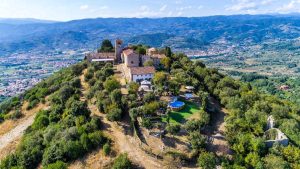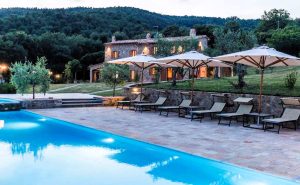Events in Italy 2025 (July – December)
Everything you need to know about events in Italy 2025 – from July to December.
There are so many events in Italy in 2025 that we have decided to write a follow-up to our last post which you have enjoyed so much. This time, we have moved on to the second half of the year and we are sure that events in Italy in 2025 from July – December will be just as much fun as those you enjoyed from January – June. Remember that 2025 is a Jubilee year in Italy. You can read all about this and everything you need to know about planning a trip to Italy in 2025 here.
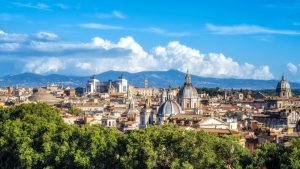
We could write a book (or even fill a library!) on Italy’s vibrant festivals, events and exhibitions. So it’s been quite a challenge to create this shortlist for you to enjoy. Here are some of the most important events in Italy in 2025, along with some of our (potentially) less well-known favourites.
July Events in Italy 2025
Festa della Madonna Bruna 2025, Matera
The Festa di Maria Santissima della Bruna takes place every year in Matera. While the main festivities are on 2 July, you will find celebrations across the whole week. This festival in honour of the Madonna della Bruna has been taking place since 1389. Today, the event means several days of celebrations with lights and market stalls filling the streets along with music and processions. The festival begins with a parade of shepherds who make their way through the town. However plenty of other processions follow!
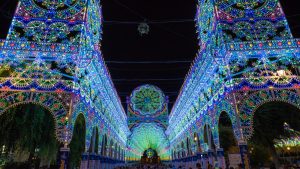
The most important involves the statue of the Madonna and child. The is impressive statue is taken to a float crafted from papier-mâchè, which is positioned near the Church of Annuziata. The procession then continues with men on horseback leading the float to Matera’s cathedral and then carried three times around the square. Finally, the statues are placed inside. Spectators may then be surprised to see the float is smashed to pieces by those gathered with everyone desperately trying to grab a piece of it. People believe that doing so will bring them good luck for the following year. The day’s festivities come to an end with a spectacular firework display.
Ancona Jazz Festival 2025
In 2025, Ancona, the capital of the Marche region, will host a jazz festival as it has done each July since 1973. As always, this is in celebration of this wonderful musical genre. The programme and dates, change each year but what is always guaranteed is that Ancona Jazz will always attract an eclectic and talented group of jazz musicians from all over the world. There are always some incredible performances, concerts and events over the course of the fortnight. Visitors can buy a card which offers unlimited access to the various events held across the city during the festival.

Siena Palio 2025
As possibly Italy’s most famous festival, and certainly one of its oldest, the Siena palio takes place not once but twice a year! Both 2 July and 16 August. The palio in July is the Palio of Provenzano, is in honour of the Madonna of Provenzano.
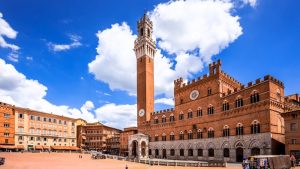
Essentially, this is a competition between ten of the seventeen contrade in Siena. The contrade are wards and every resident of Siena will belong to a contrada. There was once 59 of them, however today there are just seventeen remaining. However only ten actually compete in the palio. Of these, seven take part by right and the remaining three gain their place by being lucky enough to be drawn via lot (tratta). Interestingly, each jockey only knows which horse he will be riding four days prior when these lots are drawn.
A spectacular parade of flag wearing in medieval costumes kicks-off the Palio with their grand pageant – the Corteo Storico. The flags display the unique emblem and colour of the contrada they represent. As you pass through the city, flags of the contrade are displayed on buildings throughout Siena, so you can certainly be sure as to which contrada you’re passing through.
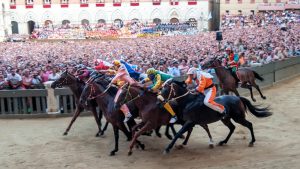
The main event involves the ten horsemen riding bareback around the Piazza del Campo three times. The winner is the first rider to cross the finishing line. The competitors are trying to win the coveted drapellone (large drape) which is a large, uniquely painted silk canvas. This is designed by a different artist each year. The winning contrada gain the honour of displaying the drappellone in their museum as part of the celebrations.
Looking for accommodation in Tuscany? Discover our collection of Tuscany Villas and apartments here.
Quintana 2025, Ascoli Piceno
July and August is ‘Palio Season’ in Italy. The palio in Siena is just one of many palios which takes place annually. If you head to Ascoli Piceno on the second Saturday in July (or on the first Sunday in August), you will have the pleasure of enjoying the Quintana. This is a Medieval jousting tournament, and is one of the oldest in Italy.
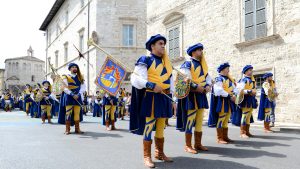
Just as in Siena, events begin with a grand procession. The different Sestieri of the city battle each other to be crowned winner of the palio. As will be familiar from festivities in Siena, every Sestiere has its own colour, coat of arms and even its own knight! The main horse race is preceded and followed by other events. Highlights are the historical parade and the flag wavers palio. However, the packed stands spilling over with jovial spectators cheering on their favourite champion are always a joy to be part of.
Stresa Music Festival 2025
Beginning in mid July, running for six weeks, a series of concerts take place in and around the popular lakeside town of Stresa on the banks of Lake Maggiore. This event has been running annually since 1961 and is now considered to be one of the leading classical music festivals anywhere in Europe. The concerts showcase everything from jazz to opera and all with the stunning backdrop of the Italian Lakes.
Discover our stunning collection of Lake Maggiore villas and apartments here.
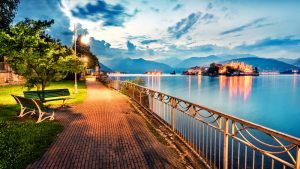
L’Ardia di San Costantino 2025, Sardinia
Also in July, one of Sardinia’s largest festivals, takes place in the village of Sedilo in the north of the island. Dating back many hundreds of years, it celebrates St Constantine who became a Roman co-emperor in 306AD. As the story goes, Constantine’s brother in law, Maxentius, declared war on him. However, Constantine successfully defeated him at the Battle of the Milvian Bridge in 312AD. During the festival, the battle is skilfully re-created with a horse race in the Sancturio di San Constantino. Spectators look-on as the two riders – dressed to represent the Roman brothers – battle it out.
August Events in Italy 2025
Castrum Sarnano 2025
One of our most favourite festivals in the run up to Ferragosto (see below) is in Sarnano, Le Marche. in the days running up to the 15th August, the town is transformed back in time into a magnificent Medieval scene. As you cross through the entrance gates, you’ll need to exchange your money for the local Medieval currency – Sarnano denari. Then you will be able to make purchases from the ancient traders, whose stalls line the streets of this picturesque Le Marche town. These include a cartographer, carpenter, astronomer, blacksmith, architect and many more. All are keen to offer you their humble services in exchange for your Sarnano denari.
Wherever you wander, you’ll find fire eaters, jugglers, archers, belly dancers, sword fighters, fortune tellers, minstrels and artists. A real authentic taste of yesteryear. Meanwhile, in the piazzas and bars, you’ll be able to enjoy some magical musical and theatrical performances.
Looking for somewhere to stay in Le Mache? Discover our stunning collection of Le Marche villas and apartments here.
Ferragosto 2025
Widely known as the modern bank holiday – Ferragosto – dates back to the time of Mussolini. He announced the 15th of August a bank holiday in his attempts to bolster Italy’s national identity. Today, Ferragosto marks the unofficial pinnacle of Italy’s summer holiday season. As a result, many businesses choose to just shut from this date until the beginning of September. Spectacular fireworks displays mark the evening celebrations in towns and cities right across Italy and there is a real air of celebration. This event in Italy 2025 is always worth joining in with – you’ll be sure to have lots of fun as locals let their hair down for their summer break.
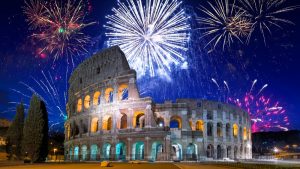
Rossini Opera Festival 2025
This annual festival is a celebration of Rossini’s music and takes place every August in the coastal town of Pesaro in Le Marche. Pesaro is in fact the birthplace of composer Gioachino Rossini. During the festival, operas are performed both in the smaller historical Teatro Rossini as well as at the modern Adriatic Arena which can seat up to 11,000 people. Discover more bout Pesaro and the stunning region of Le Marche here.
Macerata Opera festival 2025
Still in Le Marche, this region offers music for all tastes across the Summer months and are some of the highlights of these events in Italy 2025 . Macerata is famous for its iconic opera house – the Sferisterio. As one of the most prestigious and acclaimed open-air theatres in Italy, it provides a wonderful setting to enjoy some wonderfully talented opera singers perform in a warm Le Marche evening. The Macerata opera festival is an annual three week event which takes place at the open air theatre. Since its beginnings, the festival has welcomed some of the world’s best operatic performers. These include Luciano Pavarotti, Montserrat Caballé and Placido Domingo. In 2025 the festival will celebrated the 61st anniversary and we hope it continues for many more. Preview the program and book your tickets in advance here.
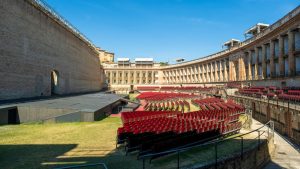
Summer Jamboree 2025
Now for something a little bit different form the Le Marche summer music scene. Senigalia’s summer jamboree is one of our favourite music festivals in Le Marche. In 2025 it will take place from 1 – 10 August. There are dozens of free concerts to enjoy, all celebrating American music and culture of the 1940s and 1950s. What’s more, to really get into the mood, there’s a brilliant vintage market every evening selling 40s and 50s memorabilia and delicious street food. Another highlight is the vintage car parade that will be sure to whisk you back in time as you admire the classic cars.
Siena Palio 2025 (Round 2!)
It’s time for another palio! Round two of the Siena palio takes place every year on 16 August. This time, it’s the Palio of the Assumption, which is held in honour of the Virgin Mary’s Assumption. Even though events mirror those in July, there’s no reason at all not to enjoy both events in Italy in 2025.
Ravello Festival 2025
Every year, the Ravello Music Festival takes place in both Ravello itself and a number of other towns and villages along the spectacular Amalfi Coast. If you’re a music lover, this is a must-visit event in Italy 2025. Often referred to as the Wagner Festival, the event has taken place every year since 1953. To begin with, it was a celebration of the visit by the German composer Richard Wagner to Ravello in 1880 and was a way for the town to boost tourism.
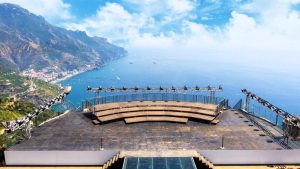
Much of the original emphasis of the festival was on Wagner’s music, however today it has evolved into a two-month-long festival. These days it features a full breadth of musical performances, from large orchestras to small chamber groups and jazz quartets. The highlight is the sunrise concert, which takes place at dawn on 11 August. Looking for accommodation on the Amalfi Coast?
Discover our stunning Amalfi Coast villas here.
Venice Film Festival 2025
The Venice Film Festival is now one of the most important events in the film industry calendar. An annual event, it runs from the end of August and across into the first week of September. In 2025, this is from 27 August – 6 September. Festivities take place on the Venice Lido, it’s aim is to promote and raise awareness of all aspects of international cinema.
September Events in Italy 2025
Regata Storica 2025, Venice
This event traditionally takes place on the first Sunday in September. In 2025 this is the 7th September. The Venice Regatta (Regata Storica) is held on the city’s Grand Canal and it is one of the oldest events that takes place in Venice. Dating back to the late 13th century we think it’s one of the finest events in Italy 2025.
To begin, there is a ceremonial parade, during which a magnificent fleet of historical boats, occupied by Venetians wearing traditional costumes, travel along the Grand Canal. This includes the bisonni (eight-oared gondolas), the balotine (six-oared gondolas) along with the ceremonial, and highly decorated gondolas belonging to the various rowing clubs of Venice.
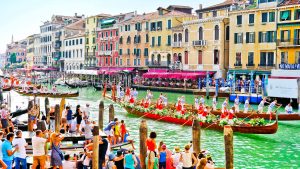
Following the grand opening, the competitive event begins. There are many regattas, from events for youngsters, one for women, as well as a men’s race. You will find the starting line in front of the public gardens in the Castello Sestiere. Here, a rope – spagheto – stretches across the water to mark the starting point. Competing boats must then make their way from here around a pole found in the centre of the Grand Canal. This is in front of the Church of Sant’ Andrea de la Zirada and they then must return to the finishing line – marked by the Machina. The latter is placed on a beautifully painted wooden raft. The prize giving ceremony also takes place here.
After the various races, the canals are filled with boats of all shapes of sizes – packed with joyous Venetians celebrating. Back on dry land, there are street performers and artists to provide plenty of entertainment in Venice’s alleys and piazzas too.
Formula 1 Italian Grand Prix 2025
Perhaps the most exciting event in the Formula 1 calendar, this year is the 96th edition of this incredible event. As always, it takes place at the iconic Autodromo Nazionale Monza and in 2025 the main event will be on 7 September. However, there will be qualifying and other racing from the 5th. Tickets and more information can be found here.
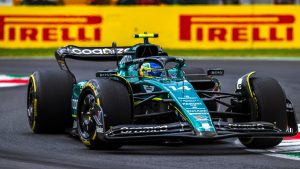
Festa della Rificolona 2025, Florence
This, the annual Festival of the Paper Lantern, will take place on 7 September 2025. The event’s roots are in Christian tradition, which states that the Virgin Mary was born on 8 September. Back then, the day would have attracted many hundreds of farmers and rural labourers into the city to pay their respects. As they travelled at night to make it to the services in time, they would carry lanterns with them to light to way. This tradition still continues today. However, these days celebrations are much smaller than they would have been historically.
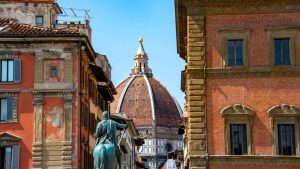
During the Festa della Rificolona, on the eve of 8 September, Florentines carry paper lanterns on the end of a wooden stick as they walk from the Piazza Santa Felicita to the Piazza Santissima Annunziata. To add to the festivities, a wonderful – and huge – market is held in the piazza on the 6 and 7 September. This is intended to reflect the way farmers would once have brought their produce into the city with them to sell.
Click here to discover our stunning Florence apartments.
Luminara di Santa Croce 2025, Lucca
It’s no secret that here at Bookings For You we love Lucca and September is the perfect time visit. Every year on 13 September, the electric lights in the city are switched off and instead, Lucca is lit up with thousands of candles for the Luminara di Santa Croce. This important religious festival celebrates the legendary Volto Santo crucifix – a wooden carving of Jesus Christ that stands over two metres tall. It is believed to have been sculpted by Nicodemus, who assisted Saint Joseph in placing Christ in the tomb following his crucifixion.
It is widely believed that the crucifix came from Palestine to Lucca in AD 782. Today it’s home is in the Cathedral of San Martino in Lucca. Legend has it, Nicodemus didn’t finish carving the face but it miraculously appeared while he was asleep The story says he then hid the crucifix in a cave in Lebanon, where it remained undiscovered for centuries.
At about 8pm on 13 September, a procession from the Church of San Frediano in Lucca, makes its way to the Cathedral of San Martino – along with a banner portraying the Volto Santo crucifix at its head. Priests wearing white robes lead the way singing prayers and a band provides accompanying music. Lucca’s residents join the festivities dressed in historic costumes. At 11.30pm, a spectacular show of fireworks ignite the sky to provide the perfect finale.
Discover our stunning Lucca villas here.
Couscous Fest 2025, Sicily.
Now for a foodie event in Italy 2025. Couscous fest takes place in San Vito lo Capo (Palermo) every September and has done since 1998. This Couscous Festival celebrates the Arab influences on Sicilian cuisine and now attracts many hundreds of thousands of visitors. Chefs from all over the world come to take part and attempt to create the best version of this ancient Arabian delicacy. That said, couscous isn’t the only foodstuff celebrated, however it is certainly the star of the show! During the event, there are cooking shows, wine tasting, talks, music performances and so much more. In 2025, the festival will take place from 19-25 September.
Discover our stunning Sicily villas here.
La Festa di San Gennaro 2025, Naples
September 19th marks the Feast of Saint Gennaro, the Bishop of Benevento. He was persecuted for his Christian beliefs, before being beheaded in 305 AD. The saint’s relics (including two sealed vials of his blood) are kept in the Duomo in Naples. Every year on the morning of 19th September, many thousands of Neopolitans gather in the Piazza del Duomo in. They are all hoping to see the saint’s blood liquefy. This is known as the Miracle of San Gennaro.
Spectators watch in awe, as the Cardinal removes the vials of blood from the chapel and processes with them and a bust of the saint to the cathedral altar. Visibly holding their breathe, the crowd waits to see if the blood liquefies (which it usually does). If it doesn’t, then it is considered a bad omen. Following this ritual, the church bells ring out and Bishop parades the liquified blood to the excited crowds in the piazza.
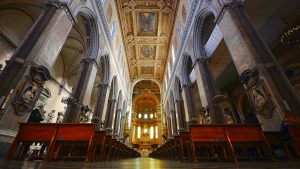
Following these ceremonial events, the vials are on display in the cathedral for the next eight days. As is typical of an Italian festival, there are plenty of other events that make up the festivities, including a religious procession through the streets. It’s worth noting that the miracle of San Gennaro’s blood also takes place on 16 December and on the Saturday before the first Sunday in May. So there’s plenty of opportunity to be part of this quite unusual spectacle.
Milan Fashion Week 2025
Milan Fashion Week takes place twice a year. Each year the Autumn and Winter collections are presented in January and February and the Spring and Summer collections in September and October. Designer brands put on cat-walk shows in some of the city’s most beautiful spots. Even though access to the shows are only open to a select few, many of them are live-streamed and available to view on a big screen in one of Milan’s main squares. And even if you can’t attend the events themselves, the city has an electric atmosphere and buzz to it during the Fashion Week. In 2025, Milan Fashion Week takes place from 23 to 29 September. If you’re a fan of fashion, it is one of the events in Italy 2025 that you just cannot miss.
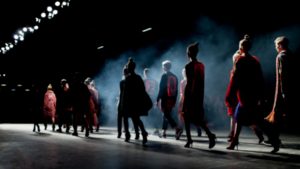
October Events in Italy 2025
Autumn is one of our favourite times of year in Italy. It’s the season when a whole plethora of food festivals take place – celebrating the bountiful harvest that nature provides at this time of year. And as self-confessed foodies, these are some of our favourite events in Italy in 2025. There are mushroom festivals, chestnut festivals, olive oil festivals and so many more. It would be impossible to list them all but we’ve included a taste of some of our favourite food festivals in 2025. We hope this gives you a flavour for the sorts of food-events you will find in Italy at this time of year.
Chestnut Festivals 2025
Toward the end of September but predominantly in October, there are several festivals to celebrate the chestnut harvest in Italy. Most of these take place north of Rome with many being in Tuscany. Perhaps the most well known is held in Monticello Amiata, from the Friday to Sunday on the second weekend in October. This three day festival – Festa della Castagna – celebrates everything we love about the humble chestnut! The sweet smell floods the streets as large pans (tegliate) are positioned throughout the town to demomstarte the roasting ritual.
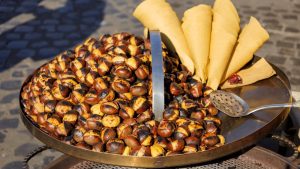
As an alternative, one of the longest celebrations of the chestnut takes place in Marradi at the Sagra delle Castagne. Festivities take place in the town every weekend in October. The streets are filled with food stalls offering a selection of delicious creations – all made using chestnuts. Some of our favourites are marmalades and jams, pasta (tortelli di marroni) cakes and puddings (torta di marroni and il castagnaccio).
Other festivals that celebrate the chestnut include: Castagnata d’Autunno in Bagno Vignoni at the end of October, the Bacchereto chestnut festival and the Palaia chestnut festival on the last Sunday in October. Also worth a visit are the Piancastagnaio chestnut festival and the two day Castagnalandia festival which takes place every year in Castelnuovo Val di Cecina, on the third weekend of October. And finally there is the Festa del Marrone in Campiglia d’Orcia. Here the streets are filled with a kaleidoscope of vibrant colours and the humble chestnut is once again celebrated in its ever more creative delectable forms.
International White Truffle Fair 2025, Alba
This world-famous truffle fair takes place every weekend between October and December. Celebrating the tuber magnatum Pico, there is no better time to sample and buy the famous white truffles that are native to the woods around Langhe Roero and Monferrato. What’s more, the fair includes historical re-enactments and events along with cookery demonstrations, tastings and so much more.
Looking for accommodation in Piedmont? Click here to discover our stunning Piedmont villas.
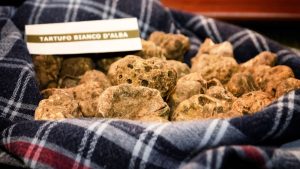
Acqualagna White Truffle Fair 2025
Alba is certainly not the only town to host a truffle fair. Back in Le Marche, the week-long white truffle fair takes place in Acqualagna annually in October or November. Attracting truffle-buyers from around the world, as always ever keen to get their hands on this prized Italian delicacy. Remarkably, nearly two thirds of Italy’s entire truffle production comes from Acqualagna. Visitors to the event will find enticing stalls lining the main square. Tastings, cooking competitions and exhibitions take place across the seven days and there are plenty of opportunities to buy truffles and other local food specialties too. Discover more about Le Marche here.
Pistachio Festival 2025, Sicily
Each year in October, the town of Bronte near Mount Etna, hosts one of our favourite Italian sagras to celebrate the humble pistachio. This tasty nut which grows on the fertile slopes of the volcano, inspires Sicilian cooking year-round. However, this festival is a real salute to the green goddess! A great variety of pistachio-inspired dishes are on hand for visitors to go nuts for during the Sagra del Pistacchio which in 2025 will celebrate its 34th year.
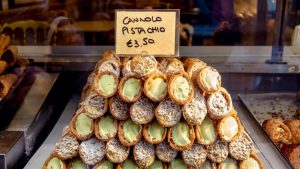
Sagra del Tordo 2025, Montalcino
The Sagra del Tordo in Montalcino takes place on the last Sunday of October and has done since 1958. It translates literally as the ‘song thrush festival’. This is to reflect the age-old tradition of hunting in this area, as a result of bird migration. The festival involves participants from each of the four districts of the town taking part in an archery competition. To mark the start of the festival, the town crier releases a number of thrushes. Meanwhile hundreds of residents add to the atmosphere by dressing up in Medieval costumes and parading through the streets for visitors to admire.
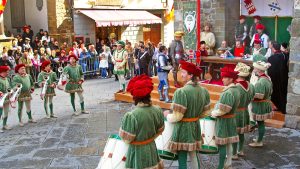
Premier Padel P1 2025, Milan
Finally something to help burn off the delicious food – although perhaps not as a spectator! This year Milan showcases the rise of Padel which has taken the world by storm. The Premier Padel tournament takes place from October 10-12. Take the opportunity to watch the world’s best players take swing on the global stage.
November Events in Italy 2025
All Saints’ Day
Even though Halloween isn’t a recognised holiday in Italy, the influence of traditional American Halloween customs are beginning to creep in. For much of Italy, this is much more a time to remember lost loved ones and visit their graves. More commonly, Italians celebrate not on 31 October but on the following day – All Saints’ Day – on 1 November. In Italy, November 1 is celebrated as All Saints’ day and is both a religious and public holiday. Known as Tutti i Santi or La festa di Ognissanti, across the country, Italians use this day to celebrate and remember those who have entered heaven.
Festival dei Popoli 2025, Florence
Founded in 1959, the Festival dei Popoli is a renowned annual film festival that takes place in Florence and 2025 will mark the 65th edition. Interestingly, it is also the oldest film festival in Europe dedicated to documentary cinema. This week-long event, which includes several screenings throughout the city, attracts people from all corners of the globe. Dates for 2025 are yet to be confirmed but it’s likely to take place between 5 and 13 November.
Eurochocolate 2025
Now for something a little sweeter! Perugia, Umbria, hosts 10-day celebration of chocolate annually in October. Perugia is well known for its chocolates, thanks to being the HQ for the much-loved Baci chocolates, which are (according to their website at least!) the most popular chocolate brand in Italy. In 2025, Eurochocolate will take place from 14-23 November and is likely to attract nearly a million visitors to the city. Read about the Spring instalment of this chocolatey festival in our post here. If you’re traveling with children (or chocolate-loving grownups!), this has to be on your list of events in Italy 2025.

Feast of Our Lady of Good Health 2025, Venice
November 21st marks the Feast of Our Lady of Good Health in Venice and is one of the most important religious events in Italy 2025. Celebrations have been taking place every year since 1631, although it’s believed that the roots of the festival go as far back as Medieval times.
In 1630 and 1631, swathes of northern Italy were hit by a wave of the plague. In Venice alone, 47,000 people died. Struggling to manage the situation, in the height of the epidemic, the government here organised a procession of prayer to the Virgin Mary for 3 days and nights. The Doge also made an announcement: if Venice survived the plague, he would build a temple as a sign of gratitude and thanks. Fortunately, soon after the procession, the epidemic died out. In way of thanks thanks to Mary, building of the great Basilica in the Dogana da Mar district began. It was finally completed in 1687.
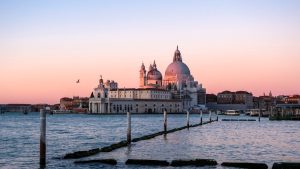
These days, the citizens of Venice still give thanks to the Virgin Mary on 21 November and once hourly masses take place in the Basilica of Saint Mary of Health. To make it easier for worshippers to access, a temporary iron and wooden bridge – the votive bridge – is erected on the Grand Canal a few days before the Feast.
Feast of Santa Lucia 2025, Syracuse
To mark Santa Lucia (Saint Lucy) festivities in Syracuse begin on 30 November and continue for 3 weeks, until 20 December. It begins, when a parade travels through the streets of the town. Later, on 9 December, the silver simulacrum of Santa Lucia goes on display in the chapel dedicated to her within the cathedral. Festivities continue on until on the 13 December, a procession carrying her relics and the silver simulacrum from here to the Basilica of Santa Lucia al Sepolcro begins. Somewhat ceremoniously escorted by twelve cilii (large wooden candelabras), the Senate Carriage follows close behind. This solemn event goes on for several hours with pilgrims shouting Siracusana jè! as the procession passes by. As a sign of their thanks, many walk the path barefoot. Finally, bells ring-out to announce its arrival at the church.
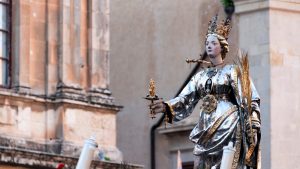
The following 8 days see crowds gather to visit the Saint and the Martyr’s tomb in the Basilica. The relics remain on display here, before they return to the Cathedral on 20 December. To mark the end of the event, there is another long procession, as the Saint makes her way back, via the Basilica Sanctuario della Madonna delle Lacrime and the Umberto I Hospital. There is also a stop at the Ponte Umbertino. Here, fireworks light up the sky to greet the Saint’s return.
December Events in Italy 2025
Feast of the Immaculate Conception 2025
December 8th marks the Feast of the Immaculate Conception. This is a public holiday meaning most people enjoy a day off. It also serves as the official start of the Christmas period for Italians. Many Italians like to celebrate the occasion by putting up their Christmas decorations.
As an important date in the Roman Catholic calendar, the feast marks the day when Mary herself was conceived. Catholics believe that her mother, Saint Anne fell pregnant in the usual biological way. However, they also believe that the conception was immaculate since it involved the intervention of God, who they believe absolved Mary of sin.
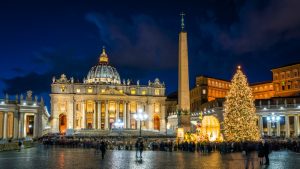
Throughout the country, special celebratory masses take place. In Rome, the Pope lays a wreath at the base of the Colonna della Immacolata statue in the Piazza Mignanelli. A representative from the Italian fire service will place a floral wreath on the arm of the statue. Elsewhere, many towns celebrate with music, entertainment and parades. In both Abruzzo and Puglia, the day is marked with the lighting of bonfires. Meanwhile, the city of Naples lights up for the festivities with magical illuminations in the Rione Sanita district. There are also the more traditional fairs of San Biagio dei Librai and San Gregorio Armeno.
Christmas Markets
In December, Italian Christmas markets take over many of the piazzas in major towns and cities. These are certainly some of our favourite events in Italy in 2025. That said, Italy’s smaller towns and villages don’t like to be outdone and many also hold magical Christmas markets during the festive season. Perhaps the biggest is in the Piazza Navona in Rome, at Oh Bej! Oh Bej! or in Milan, famous for celebrating the city’s patron saint, Saint Ambrose. Of course, many Christmas markets will give you the chance to meet Babbo Natale (Father Christmas) while he prepares for the big day.
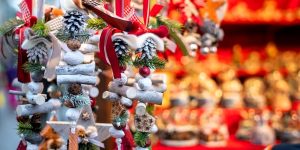
Live Nativity Scenes
We can’t talk of Christmas in Italy without giving a mention of the live nativity scenes (presepio) that take place across the country. The tradition began when Francis of Assisi staged the first-ever living nativity scene in the early 13th century in the village of Greccio. In the following two centuries, the tradition of live nativity scenes spread to towns and villages across Europe. In Italy, the tradition is still going strong today.
Our favourite living nativity scene is in Genga, Le Marche. It takes place between the 26 December and 29 December every year. Set in a cave in the beautiful Frasassi Gorge, every year 300 actors re-enact the nativity scene. This has earned it the title of the largest living nativity in the whole world. All the performers make their way up to the cave, dressed as local craftsmen of the time – from blacksmiths to bakers and from cobblers to carpenters. And to add to the magic, proceeds from the event all go to charities and good causes.
Meanwhile in Rome, presepi can be found in the Piazza Euclide, at Santa Maria in Travestere, the Piazza del Popolo, and also at Santa Maria d’Aracoeli on the Capitoline Hill. These are all well worthy of a visit, if you’re in the capital.
Christmas Day and St Stephen’s Day
As is the case in much of Europe, both 25 and 26 December are public holidays in Italy. During this time, Italians gather at home to spend in the company of family and friends. As I’m sure you can imagine, some seriously wonderful food is prepared and shared to celebrate Christmas Italian style. To learn more about the best Christmas destinations in Italy, click here.
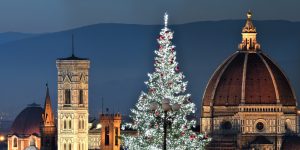
Umbria Jazz Winter 2025
As always, the Winter edition of the Umbria Jazz Festival offers yet another chance for music lovers to immerse themselves in some incredible jazz performances. These can be enjoyed across seven different venues throughout Orvieto. In 2025 the event takes place from 28 December – 1 January. More than 150 performers will take part during the five days and coinciding as the event does with Capodanno (New Year’s Eve), it really is a fantastic event. As many of the musicians are ‘in residence’, there are also lots of opportunities to listen to the same performer more than once. The main venue for performances is the Teatro Manincelli. However, other venues include the Emilio Greco Museum, the Palazzo del Capitano del Popolo and the Palazzo dei Sette.
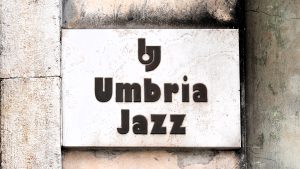
For those who enjoy staying up late, also at the Palazzo dei Sette, great fun can be had at the jam sessions which have been one of the most identifiable rituals of jazz since its beginnings. These start at around midnight with the house band and continue into the early hours. And as has become tradition, the Funk Off band parades through the streets of the Città della Rupe.
Looking for accommodation in Umbria? Click here to discover our stunning collection of villas and apartments in Umbria.
And that’s it! We hope you enjoyed reading about these events in Italy 2025 and we hope we managed to include something for everyone to make a trip to Italy in 2025 full of the magical moments and memories it deserves. If your trip is in the first half of the year, then remember to also check out our post on events in Italy 2025 from January – June. And don’t forget to head over to Bookingsforyou.com to discover our stunning collection of villas and apartments in Italy.




